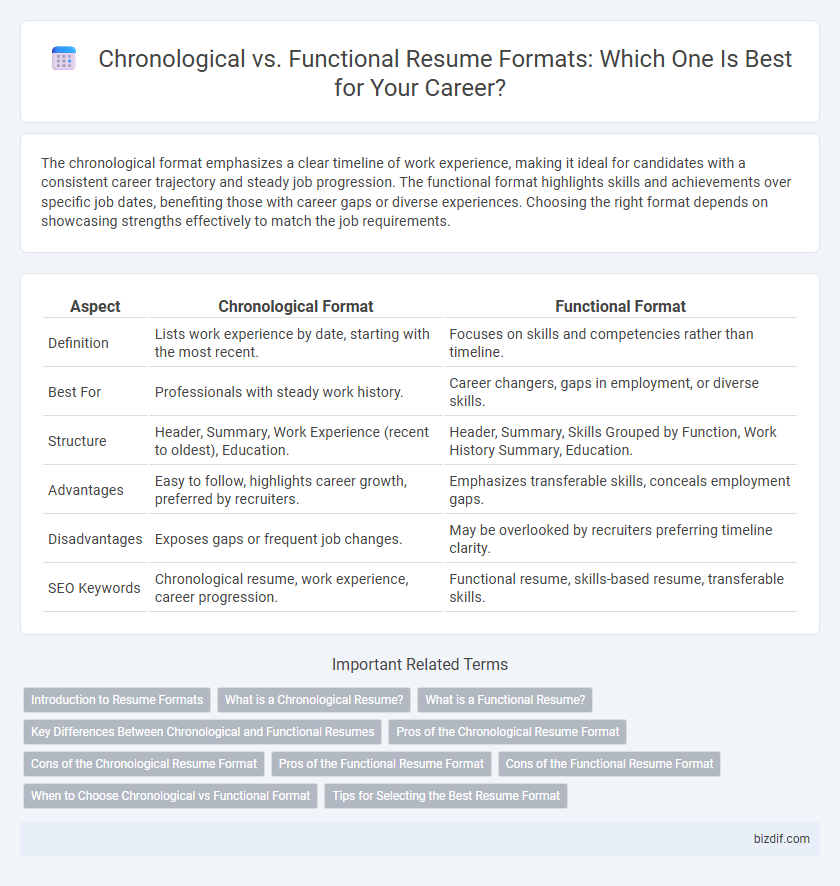The chronological format emphasizes a clear timeline of work experience, making it ideal for candidates with a consistent career trajectory and steady job progression. The functional format highlights skills and achievements over specific job dates, benefiting those with career gaps or diverse experiences. Choosing the right format depends on showcasing strengths effectively to match the job requirements.
Table of Comparison
| Aspect | Chronological Format | Functional Format |
|---|---|---|
| Definition | Lists work experience by date, starting with the most recent. | Focuses on skills and competencies rather than timeline. |
| Best For | Professionals with steady work history. | Career changers, gaps in employment, or diverse skills. |
| Structure | Header, Summary, Work Experience (recent to oldest), Education. | Header, Summary, Skills Grouped by Function, Work History Summary, Education. |
| Advantages | Easy to follow, highlights career growth, preferred by recruiters. | Emphasizes transferable skills, conceals employment gaps. |
| Disadvantages | Exposes gaps or frequent job changes. | May be overlooked by recruiters preferring timeline clarity. |
| SEO Keywords | Chronological resume, work experience, career progression. | Functional resume, skills-based resume, transferable skills. |
Introduction to Resume Formats
Chronological and functional resume formats serve distinct purposes in job applications. The chronological resume emphasizes a detailed work history organized in reverse chronological order, ideal for candidates with consistent career progression. Functional resumes highlight skills and competencies, prioritizing abilities over specific job timelines, making them suitable for career changers or those with employment gaps.
What is a Chronological Resume?
A chronological resume lists work experience in reverse chronological order, starting with the most recent job first, highlighting career progression and stability. It emphasizes specific job titles, companies, and dates, making it ideal for candidates with a solid work history relevant to the position. Recruiters prefer this format as it clearly showcases consistent employment and professional growth.
What is a Functional Resume?
A functional resume emphasizes skills and experience over chronological work history, highlighting competencies relevant to the job. This format is ideal for career changers, gaps in employment, or those with diverse skill sets seeking to showcase their abilities effectively. Employers quickly identify key strengths, making functional resumes valuable for demonstrating transferable skills.
Key Differences Between Chronological and Functional Resumes
Chronological resumes highlight a candidate's work history by listing jobs in reverse chronological order, emphasizing consistent career progression and relevant experience. Functional resumes focus on skills and qualifications rather than job titles or dates, allowing applicants to showcase competencies while downplaying gaps or frequent job changes. Choosing the right format depends on whether you want to emphasize your career timeline or specific expertise to align with the job requirements.
Pros of the Chronological Resume Format
The chronological resume format highlights a clear, time-ordered career progression, making it easier for employers to track job experience and career growth. It showcases loyalty and stability by emphasizing long-term positions and consistent work history. This format aligns well with applicant tracking systems (ATS) due to its structured layout and familiar headings.
Cons of the Chronological Resume Format
The chronological resume format often highlights employment gaps and lacks flexibility for career changers, which can disadvantage applicants with non-linear work histories. It prioritizes job titles and dates over skills, potentially overshadowing relevant competencies vital for certain roles. Recruiters may find it less effective in showcasing transferable skills, limiting its appeal for candidates seeking industry transitions.
Pros of the Functional Resume Format
The functional resume format emphasizes skills and achievements, making it ideal for candidates with employment gaps or career changes by highlighting relevant expertise over chronological work history. This format allows job seekers to showcase transferable skills and specific accomplishments that align with the job description, enhancing their appeal to employers focused on capabilities. It also reduces emphasis on dates, helping applicants with inconsistent work backgrounds present a stronger, more focused narrative.
Cons of the Functional Resume Format
The functional resume format often lacks clear timelines, making it difficult for employers to track career progression and assess recent experience. This format can raise red flags by obscuring gaps in employment, reducing transparency and potentially triggering skepticism. Recruiters frequently prefer chronological formats for their straightforward structure, which provides a detailed work history critical for evaluating candidate reliability.
When to Choose Chronological vs Functional Format
Choose the chronological resume format when you have a consistent work history with progressive career growth, as it highlights your job titles and dates in reverse order to showcase experience clearly. Opt for the functional resume format if you have gaps in employment, are changing careers, or want to emphasize skills over chronological work history, focusing on relevant abilities and accomplishments. Employers in traditional industries often prefer chronological resumes, while functional resumes suit freelancing, consulting, or creative fields where skills and project outcomes matter more.
Tips for Selecting the Best Resume Format
Selecting the best resume format depends on career history and job goals; chronological format suits candidates with a strong, continuous work history, highlighting job titles and dates. Functional format benefits those with gaps, career changes, or limited experience by emphasizing skills and achievements over employment dates. Tailoring the resume structure to align with the job description and industry standards enhances applicant tracking system (ATS) compatibility and recruiter readability.
Chronological format vs Functional format Infographic

 bizdif.com
bizdif.com